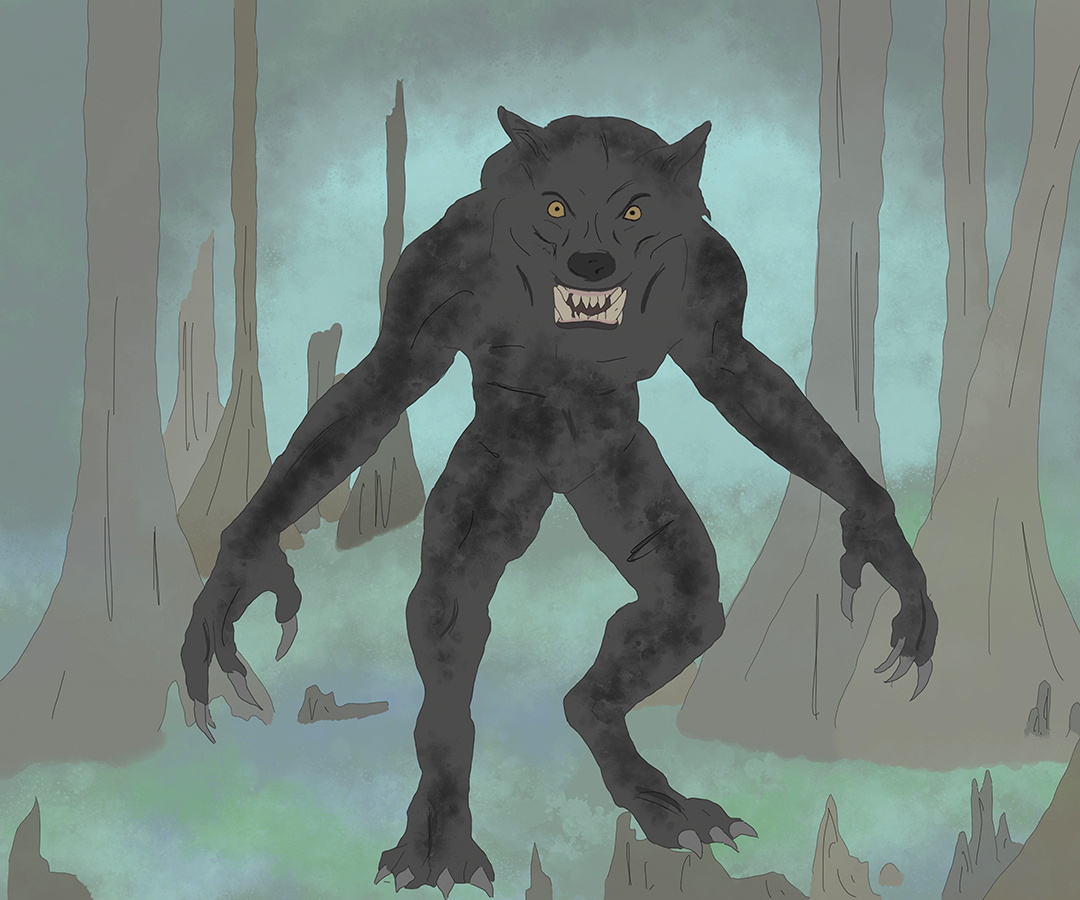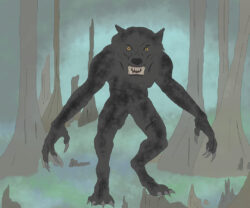Louisiana Folktales
Louisiana’s folktales have been influenced by Indigenous peoples and the many cultural and ethnic groups that have immigrated to the state.

Courtesy of the Louisiana Endowment for the Humanities
An Illustration of a rougarou by Cecilia Tisserand, 2022. Rougarou are often described as being similar to dogs, owls, birds, and humans, despite the origin of their from the French "loup-garou" or “werewolf.”
Louisiana’s rich cultural diversity is reflected in the state’s unique folktale repertoire. Folktales can be considered as part of a larger oral tradition, which can also include traditional songs, superstitions, expressions, and shared ideas about vernacular healing or other cultural practices. The Indigenous peoples of Louisiana as well as each of the many cultural and ethnic groups that immigrated to the region over the years have contributed to the state’s distinct oral tradition. Folktales, by their nature of being passed on informally, often by word of mouth, adapt to their context over time and are influenced by various communities through cultural contact.
While there are many influences from and some overlap between the folklore of Louisiana’s diverse communities, it can be helpful to think about the folklore traditions of Louisiana according to a few of Louisiana’s major regions and linguistic communities. Some folklorists often divide Louisiana into main cultural regions like North Louisiana, South Louisiana, New Orleans, etc. Within these large portions of the state, certain cultural influences appear due to past immigration patterns. Contributions from Native, African, French, Acadian, Caribbean, German, Irish, Czech, Spanish, East Asian, and other cultural groups are all evident in different ways within the folklore traditions of Louisiana.
North Louisiana
The folklore traditions of North Louisiana might best be characterized as a confluence of British-American and African American oral traditions. There are certainly many animal tales, including trickster tales, that resemble African American folklore elsewhere in the English-speaking southern United States. One also finds a strong tradition of telling “tall tales”—larger-than-life anecdotes often told in casual succession among friends and family. Folklorists such as Susan Roach and C. Renée Harvison have recorded many examples of this storytelling tradition like “The Bear-Riding Cowboy” and “A Man-Eating Varmint,” told by Lonnie Gray from Bernice in Union Parish. Oral histories and regional legends make up an important part of North Louisiana’s folklore repertoire. Tales of bandits of yesteryear like “The Winn Parish Night Riders” as well as “The Legend of Lying Horse Rock”—a supposedly cursed, horse-shaped rock covering buried treasure—are some examples of legends also collected by Harvison.
New Orleans
Some early examples of the folklore of New Orleans were transcribed by Alcée Fortier, a linguist and historian who was active in efforts to preserve French in Louisiana. His Louisiana Folk-Tales (1895) features many stories that he collected from Black Creole storytellers in New Orleans and in his native St. James Parish. These stories were the cultural product of people that experienced the history of slavery, fusing elements of French and West African folktales into a unique set of characters with morals that often highlighted clever tricksters. Such tales feature the familiar bouki and lapin as well as many other animal tales, highlighting the strong West African and Caribbean influences in this repertoire as well as a similarity to the Bouki ak Malis tales popular in Haitian folklore. A striking example of West African influence is the name of bouki, which is the Wolof word for “hyena.” Lapin, or “hare” in French, is a typical trickster figure, like the fox in the French tradition. These folklore figures align with the finding of historians such as Gwendolyn Midlo Hall who have shown that the Senegambian region and the Wolof and Bambara communities represented a large part of the enslaved population of Louisiana in the colonial period. In addition, urban legends and ghost stories abound in New Orleans, such as those surrounding figures like Delphine LaLaurie and Marie Laveau. The mystique surrounding the Crescent City, including the place of Voudou in popular imagination, has also given rise to the popularity of ghost tours based on these urban legends.
Native Folklore
Among the most well-documented of Native folktale repertoires are the Chitimacha, Choctaw, and Houma. Much of the early studies and written recordings of Native communities in Louisiana were conducted by outsiders, which can have significant consequences for how narratives are framed and categorized. For example, the creation story within one community might be perceived as a “folktale” by an outsider. Works such as David Bushnell’s study of the Choctaws of Bayou Lacombe (1909), John Swanton’s “Mythology of the Indians of Louisiana and the Texas Coast” (1907), and Katharine Judson’s Myths and Legends of the Mississippi Valley and the Great Lakes (1914) contain many etiological tales (a story that explains natural phenomena) such as “The Origin of Fire” and “Why the Blackbird Has Red Wings.” Later on, Bruce Duthu of the Houma Nation conducted one of the most extensive collections of this repertoire. In many ways the Houma oral tradition in southeast Louisiana demonstrates a noteworthy overlap between French Acadian storytelling and the Houma oral tradition. In other words, similar folklore figures existed in both traditions, reinforcing each other. Two common examples of this phenomenon are the rougarou and lutin. In French these two terms roughly translate to “werewolf” and “elf,” two figures that typically appear in what folklorists might call personal experience stories. In other words, they are not so much folktales as they are testimonies of what storytellers ostensibly witnessed. Ironically the rougarou, derived from the French loup-garou, is described as almost anything but a wolf but as being similar to dogs, owls, birds, and humans. Rather than a typical villain, the rougarou’s state is normally the result of a curse from which the werewolf seeks to free itself by drawing blood from its impending victim. The lutin is a mischievous figure that greatly resembles the bohpoli of the Choctaw tradition, which is linguistically and culturally related to the Houma Nation. Storytellers recount instances of the lutin braiding the manes of horses and riding them during the night. Perhaps the most important folk hero of the Houmas is Rosalie Courteaux, “the last great leader of the Houmas” who passed away in 1885. While little remains in terms of written traces of her life, retellings of her adventures and ardent defense of her people live on.
French and Creole Folktales
The area of South Louisiana widely recognized for its Cajun and Creole culture is typically referred to today as Acadiana, a twenty-two-parish region that roughly corresponds to the historically French- and Creole-speaking part of the state. Heroes in this folklore repertoire are typically small and devoid of great physical strength; however, they are often exceedingly sly and clever. This fact is unsurprising given the historical inequities and discrimination faced by these communities, such as slavery, the Acadian deportation (Le Grand Dérangement), and longstanding linguistic discrimination against non-English speakers. For this reason, tricksters or characters who are supposedly impotent or dull and reveal themselves to be capable of overcoming a stronger opponent are particularly prevalent. Moreover, opposition to authority and physical strength are hallmarks of Louisiana’s French and Creole folklore. Still today, two of the most iconic figures of the French and Creole speaking part of Louisiana remain bouki and lapin and have been widely collected among Creoles of color and their white Cajun counterparts. Another well-known character is Jean Sotte, the quintessential fool of Louisiana folklore. A variant of Jean-le-Sot, a figure found throughout the French-speaking world, the Jean Sotte of French Louisiana is often the victim of his own misunderstanding of his mother’s orders. In many instances, he takes his orders too literally, displaying a lack of understanding of the world around him. These tales often function on puns or homonyms, making them particularly fragile due to their inability to be translated into English and maintain their place in the repertoire. For example, in one popular episode, Jean’s mother asks him to tirer la vache. However, since in Louisiana the French verb tirer can mean “to milk” and “to shoot,” Jean shoots the family’s cow, leaving his mother in great distress.
Other fascinating folklore figures in the French- and Creole-speaking region of Louisiana include Madame Grands-Doigts and La Christine. While both figures can be associated with the Christmas and New Year holidays, Madame Grands-Doigts (Lady Long Fingers) is particularly ambivalent in that her representation varies widely from family to family, even within a relatively limited region. She is sometimes described as a punishing figure who appears to reprimand and strike fear into the hearts of disobedient children. However, other families portray her as a benevolent figure who brings fruits and small gifts to children on New Year’s Eve. La Christine is an intriguing example of German influence on Louisiana folklore, even within what is clearly considered to be Cajun culture. A derivation of das Christkind, or the Christ child figure still popular in Germany today, the term was Gallicized in the context of francophone Louisiana and, perhaps due to its proximity to the feminine first name, came to define a magical female figure (perhaps the wife of Père Noël, or Father Christmas) who would bring small gifts and fruit to children over New Year’s Eve.
Religion and natural phenomena often intersect in Louisiana’s folklore. For example, the feu follet, or “fool’s fire” can occur whenever various gases, including sulfur dioxide, emanate from decaying plant matter in swampy areas. According to popular belief, feux follets are the souls of unbaptized children who are held on earth in spiritual limbo, unable to enter heaven without having received the sacrament of baptism. The feux follets often exhibit childlike or mischievous traits, such as playfully flying around passersby or causing people to become lost in the forest or marshy areas. Another example is kooshma or cauchemar (“nightmare” in French). Mostly widely known among Creoles of color, kooshma is generally thought of as a malevolent spirit, often portrayed as female, who holds one down during restless sleep. While many folk traditions throughout the world have their own beliefs explaining the very real physiological phenomenon of sleep paralysis, kooshma often overlaps with Catholicism in that it is presumedly a punishment for sins. Likewise, specific prayers or religious objects are purported to keep kooshma away.
Isleño Folklore
St. Bernard and Plaquemines Parishes, in the southeast part of the state, is home to Spanish-speaking communities of Isleños (“islanders”). Their presence in this area dates back to the 1770s when colonists from the Canary Islands arrived there during Spanish colonial rule. A number of folktales in Isleño Spanish have been collected, such as “La Tortuga y el Conejo” (The Turtle and the Rabbit) told by Joseph “Chelito” Campo of Delacroix Island. Another iconic component of the Isleño oral tradition is the décima. Originating in Spain during the Renaissance period, the décima first referred to the poem’s octosyllabic ten-line structure. Singers such as Serafin Pérez and his son Irván Pérez mastered the traditional song, but they and others also created new décimas in adapting to current themes and their contemporary reality.
